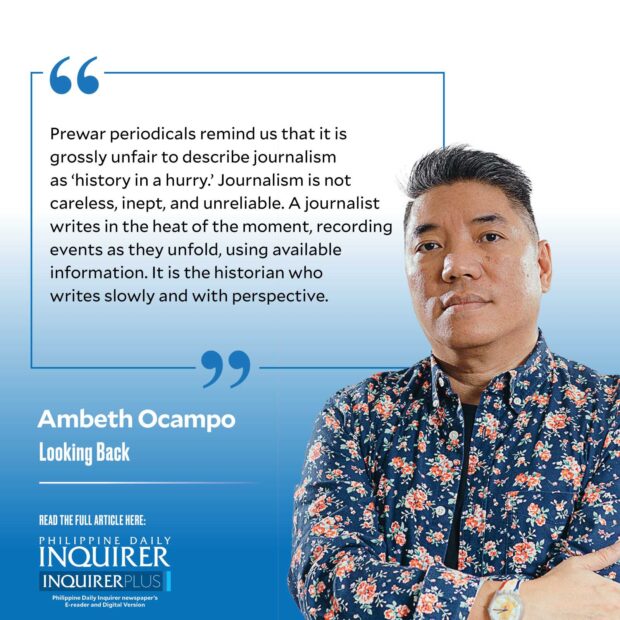History in a hurry

My Holy Week penance this year was unusual, partly because I enjoyed it. This consisted of online browsing through various prewar periodicals: El Renacimiento, La Vanguardia, Tribune (published in Manila), as well as provincial ones like Progress and the Visayas Shimbun. There were a handful of revolutionary periodicals, too, like El Heraldo de la Revolucion and La Independencia published in Malolos in 1899. I wasn’t looking for anything in particular but since technology has since improved on microfilms and photocopies the scans of these periodicals had optical character recognition allowing me to search through the entire archive by keyword. While much historical material is literally available online these days, there are more distractions like TikTok and porn.
Advertisements were very engaging and informed my last two columns on pancit and panciterias. I was surprised that many of the products sold before are still around today and available at online stores. Marca Oso is today’s Bear Brand milk. “Tiki-Tiki Zamora,” a rice bran cure for beri-beri, is still around as “United American Tiki-Tiki” ingrained in our consciousness with a catchy jingle. Then there was Scott’s Emulsion that figured in Rizal’s Dapitan clinic. Rizal’s nephews recall him repeatedly calling out prescriptions for “Emulsion de Scott,” which in Tagalog became “Emulsion ni Scott.” This was cod liver oil that was the nightmare of all children who couldn’t understand how something that tasted so bad could be good for them. Today, it is available in a pleasing orange flavor. Advertisements reveal how much the Philippines has changed in the last century, and how much has remained the same.
Benjamin Franklin is quoted to have said that the only certainties in life are death and taxes. To that, we can add politics based on the periodicals I read. There was a lot on Emilio Aguinaldo, not only on his role during the Philippine Revolution and the Philippine-American War, but also his social and civic appearances, his second marriage to Maria Agoncillo (niece of the First Filipino diplomat Felipe Agoncillo), and his run for the presidency of the Philippine Commonwealth. Naturally, the other contenders made the news, too: Manuel L. Quezon, Gregorio Aglipay, and Pascual Racuyal. He may have been the least-known candidate at the time, but Racuyal was the most fascinating because he ran for president in all Philippine elections from 1935 up to 1986 when he was finally declared a nuisance candidate.Obituaries were regular and plentiful and the ones that had resonance in that generation were those associated with the struggle for independence against Spain. Apolinario Mabini died of cholera in 1903. What made the news was the multitude that lined the streets leading to the Chinese cemetery for his funeral procession in defiance of stringent sanitation decrees against funerals during the cholera epidemic, very much like what we endured during the COVID lockdown. Mabini’s funeral rekindled the flame of resistance to colonial rule. Teodora Alonso, Rizal’s mother, also generated a multitude for her funeral in 1911. Unlike other people who merely lived like mirrors reflecting glory from Jose Rizal, his friend and confidant Ferdinand Blumentritt maintained his own light emerging as the “eminent Fiilipinologist.” When he died in 1913 in faraway Litomerice, Bohemia, now part of the Czech Republic, many provinces, cities, towns, and barangays sent formal resolutions of condolence to his widow and family for being “the great friend of the Filipinos.”Rizal’s eldest sister Saturnina “Neneng” Hidalgo de Rizal died in 1913 aged 63. When I typed out her name, a surprising news item popped up from 1912: “Rizal Sisters To Be Tried Again. Gambling Case Sent Back to the Court of First Instance.” According to the article, Saturnina and Narcisa Rizal were caught and tried with six other individuals for “gambling and conducting a gambling house in the city of Manila.” A fine of P20 each was imposed. Upon further study, the case was declared to be a public offense rather than an offense against the city of Manila, resulting in a second trial. I have yet to find the resolution of this case.
There were articles on other heroes: one on Andres Bonifacio by his contemporary Masangkay, there were articles on the assassination of Antonio Luna (that could have been used against Aguinaldo who was running for president), there was a serialized biography of Gregorio del Pilar by T.M. Kalaw translated from the original Spanish, etc. Then there was the sad case of Artemio Ricarte who fought in both the Philippine Revolution against Spain (1896-1898) and the succeeding Philippine-American War (1899-1902). He was returned to the Philippines by the Japanese during World War II and ended his life as a collaborator and traitor to his country and people. Sometimes living too long is detrimental to your posthumous reputation.Prewar periodicals remind us that it is grossly unfair to describe journalism as “history in a hurry.” Journalism is not careless, inept, and unreliable. A journalist writes in the heat of the moment, recording events as they unfold, using available information. It is the historian who writes slowly and with perspective.
Comments are welcome at aocampo@ateneo.edu




















